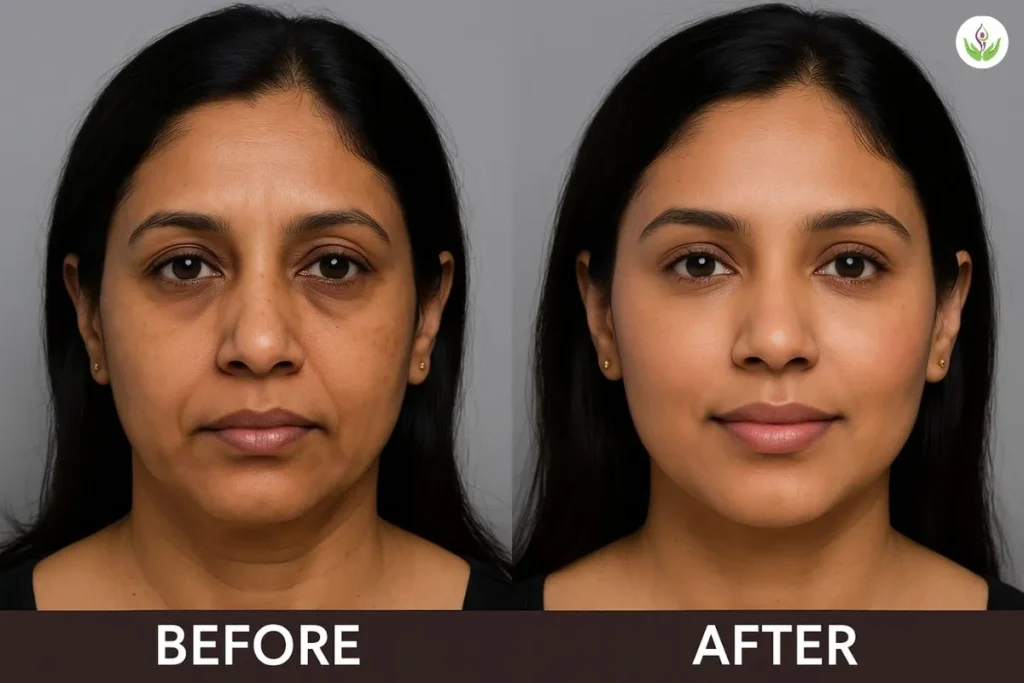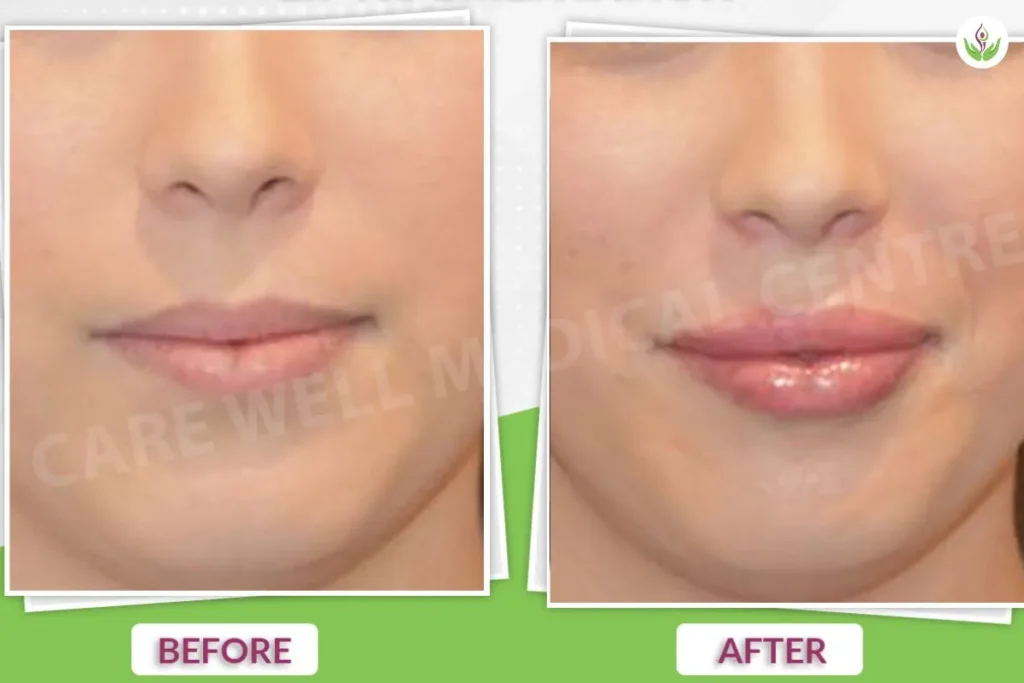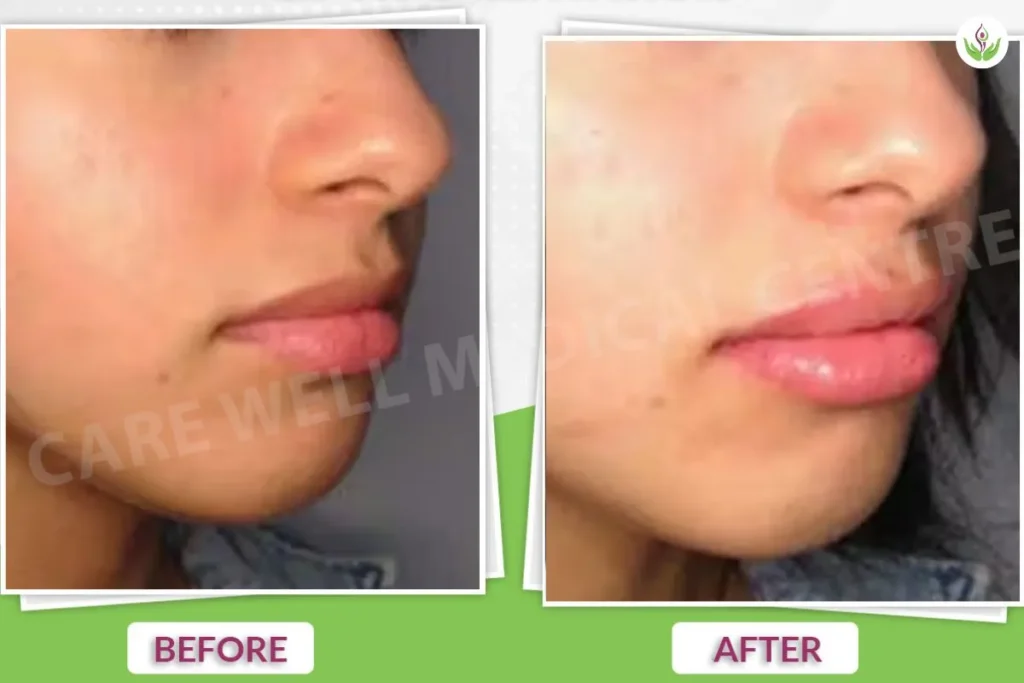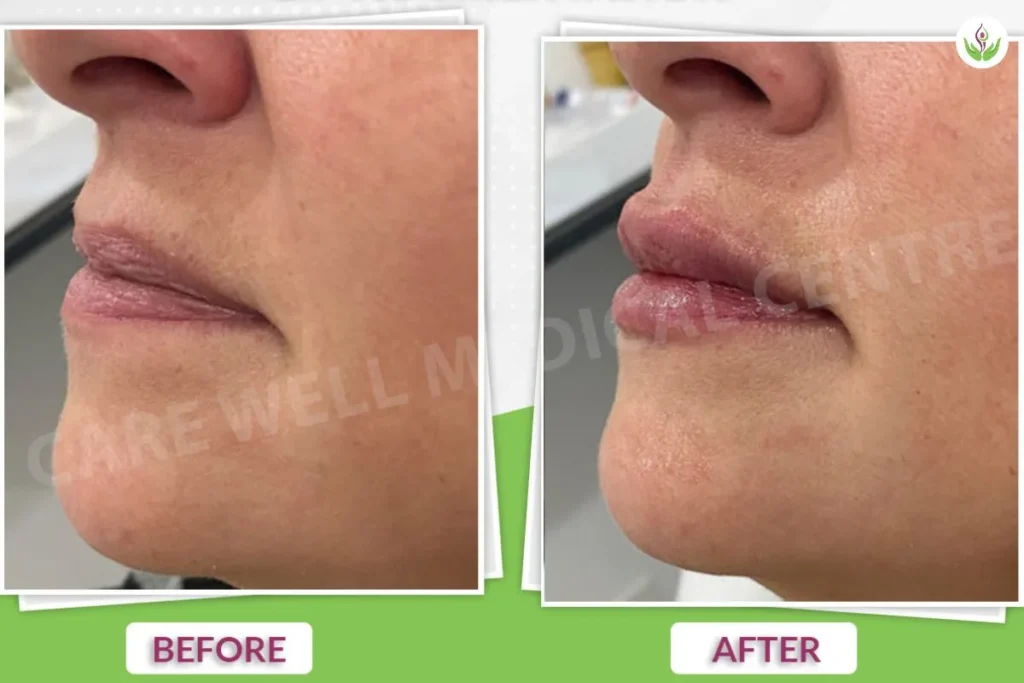
Achieve a Youthful & Sculpted Look with Dermal Fillers at Care Well Medical Centre
A combination of age, lifestyle, environment, and stress will eventually catch up with all of us, resulting in wrinkles, fine lines, and a whole lot more. Cumulatively, these changes may lead to a noticeable reduction in the firmness and luster of your skin. To restore lost volume, smoothen facial contours and wrinkles, and safely replace volume, dermal fillers may be used. We at Care Well Medical Centre also offer customized dermal fillers in Delhi under the guidance of Dr. Sandeep Bhasin. These fillers ensure a natural and long-lasting youthful appearance.
What Are Dermal Fillers?
Dermal Fillers are gel-concentrated formulas injected into the skin pores to repair the affected area, improve facial contours, and ease strains. This method is a popular choice for treating age-enhancing folds, reviving volume to thin lips, softening folds in the face, and improving scars. Fillers, commonly calcium hydroxylapatite and poly-L-lactic acid, also provide collagen stimulation.
Using the right process of dermal filler restores volume loss, ensures youthfulness, and enhances features. Dermal fillers can enhance:
- Cheeks & Mid-Face Volume: Rejuvenate and redefine facial contours.
- Lips: Don’t you want fuller and more defined lips? Our Lip Augmentation treatment in Delhi provides hydration, volume, and a perfect shape to the lips. So, what are you waiting for? Enhance your lips naturally with Care Well Medical Centre.
- Jawline & Chin: We help you provide the perfect jawline with our facial balance with contouring treatments.
- Under-Eye Hollows: Your dark circles make you look tired. Our treatment reduces dark circles and gives a refreshed look.
- Nasolabial folds and marionette lines: With our treatment, say goodbye to those deep folds around the mouth and nose.
- Hand Rejuvenation: Refill the lost volume and lubricate the fine lines.
- Temple filling: Create a soft transition between the forehead and the cheek.
- Acne scars treatment: Reduce the presence of deep acne scars and skin indentation.
This injectable treatment is used to lubricate wrinkles and fine lines. It is a non-invasive option for both men and women in Delhi, as it helps achieve youthful skin quickly. Here we have some detailed information about dermal filler treatment in Delhi.
Benefits of Fillers Treatment in Delhi
- Quick and Long-Lasting Results: Improvement is visible immediately.
- Fast and No Surgery: No anesthesia or incisions necessary.
- Natural Looking and Feeling: We will improve your appearance that still looks natural.
- Safe and FDA-Cleared Products: We only use clinically approved, high-quality dermal fillers.
- Customizable for Individual requirements: You will get treatment as per your facial anatomy.
- Minimal Recovery Time: Start your routine tasks just after the procedure.
- Collagen Stimulation: We use fillers that help stimulate natural collagen production for long-term advantages.
Do you want a glow boost? You can combine your filler results with our PRP Facial Rejuvenation Therapy for improved skin texture and collagen boost.
Risks & Side Effects of Dermal Fillers
With trained and experienced professionals, dermal fillers are generally safe. Although, like other medical products, it can cause temporary side effects. Most of the reactions are mild and heal within a few days.
Common Side Effects:
- The injection site may appear mildly red, swollen, or bruised.
- The treatment area may become tender or cause itching.
- Temporary lumps or unevenness
- Tightness or a bit of discomfort
Rare But Serious Risks:
- Infection at the injection site
- Allergic reactions
- Vascular issues or skin discoloration in case of injecting improperly
- Granuloma or nodule development in rare cases
Treatment by a qualified and experienced healthcare professional helps reduce the risks. The right professional always prefers FDA-approved products for all processes. Dr. Sandeep Bhasin at Care Well Medical Centre takes care of all the procedures for maximum safety and precision.
We look after you in case you witness rare symptoms and discomfort after the treatment.
Who Is the Ideal Candidate for Fillers?
Dermal Fillers are suitable for many. But if you want to check whether you are the ideal candidate for filler treatment at Care Well Medical Centre, ask yourself:
- ✅ Do you have volume loss in your cheeks, lips, jawline, and under eyes?
- ✅ Whether you want reduced fine lines, wrinkles, and sagging skin?
- ✅ Do you want naturally defined and hydrated plumper lips?
- ✅ Do your eyes look hollowed, or whether deep nasolabial folds make you look tired?
- ✅ Want to experience a minimally invasive facial rejuvenation?
- ✅ Expecting natural-looking outcomes gradually and getting back to work immediately?
- ✅ Do you want an anti-aging treatment that can be used to delay the aging process?
How Does the Fillers Procedure Work?
Surgeons inject the virtually painless filler in areas such as under-eye wrinkles, forehead lines, and crow’s feet. The injection process considers individual skin concerns and goals. A bit of mild discomfort occurs. However, patients can quickly return to their daily activities, indicating no downtime.
Desired outcomes require effective and customized treatment by experienced healthcare professionals. When used for youthful rejuvenation of the face, fillers are safe and effective by increasing the elasticity of the skin while smoothing out age-etched lines. Over the past few years, non-surgical methods aimed at restoring bosom contour have gained popularity owing to the trust fostered by non-invasive techniques that aid in lifting facial features with subtle sculpting.
- 1️⃣ Comprehensive Consultation – Meet with Dr. Sandeep Bhasin to discuss your objectives and a plan for the best type of filler and treatment.
- 2️⃣ Cleansing & Numbing – The Treatment area is cleansed, and numbing cream is applied for the greatest comfort.
- 3️⃣ Precise Filler Injections – Fine needles or cannulas contained in the filler help it to inject the targeted areas.
- 4️⃣ Shaping & Sculpting – The healthcare professional spreads and forms the filler to ensure its even distribution. It thus ensures a natural, youthful appearance.
- 5️⃣ Post-Treatment Care Instructions – Ensure optimal outcomes by practicing the recommended post-treatment care instructions.
The treatment spans 30-45 minutes. Immediate results are the case, and one can resume their normal work after the treatment.
Dermal Fillers Treatment Before and After Results



Comparing Juvederm and Other Dermal Fillers
Juvederm (by Allergan), a hyaluronic acid (HA)-based dermal filler that ensures smooth texture for a long time. The FDA-approved filler effectively treats augmented lips, nasolabial folds, cheeks’ volume loss. Compared to other fillers, Juvederm induces much lower puffiness initially and ensures a youthful and natural appearance, lasting up to two years.
Different Types of Juvederm Fillers & Their Uses
- ✔ Juvederm Vollure XC – It helps soften mild to severe wrinkles and folds around the nose and mouth.
- ✔ Juvederm Voluma XC – This product ensures a cheek volume addition to resolve volume loss that comes with age.
- ✔ Juvederm Volbella XC – It enhances upper and lower tips, and smooths vertical lip lines.
- ✔ Juvederm Ultra XC – It helps ensure lip volumization or remove moderate to severe facial wrinkles.
How Do Other Fillers Compare?
- ✔ Perlane – It’s similar to Juvederm. However, its enhanced thickness and density help remove deep wrinkles or restore cheek volume.
- ✔ Restylane – Several formulations of this popular HA filler help fit the area and ensure long-lasting, natural results.
- ✔ Radiesse – It uses calcium hydroxylapatite to remove deep wrinkles but may create bumps at injection sites.
- ✔ Sculptra – Using poly-L-lactic acid, this volumizer remains an effective alternative to reduce facial hallowing. However, a skilled professional should inject this because of its complexity.
- ✔ Fat Grafting – It ensures volume restoration using your fat. However, the seemingly unpredictable treatment sees results varying from months to years.
- ✔ Permanent Fillers (Aquamid, Artefill, Silicone) – Despite offering long-lasting outcomes, they may cause irreversible complications later.
Choosing the right filler is purely individual-specific, despite having safe and proven options – Juvederm, Restylane, and Perlane. Don’t opt for permanent fillers, which can cause long-term complications. So, you need to consult an experienced dermatologist or injector for the right filler.
Under-Eye (Tear Trough) Filler in Delhi – Remove Dark Circles & Hollow Eyes
Bothered by your tired-looking eyes? You can get rid of it using under-eye fillers, a non-surgical remedy to reduce hollowness, under-eye bags, and dark circles.
We at Care Well Medical Centre offer a beneficial tear trough filler treatment in Delhi using soft hyaluronic acid fillers. This formulation is designed for the delicate under-eye area.
✅ Best Fillers for Under-Eyes:
- Juvederm Volbella / Volift – These lightweight HA fillers ensure smooth, natural correction.
- Restylane-L / Teosyal Redensity II – Effectively reduces puffiness, adds volume, and removes dark circles.
- Revive / Belotero Balance – It ensures subtle enhancement and causes less swelling.
Choosing from these products requires examining your skin quality, hollowness depth, and treatment goals.
✨ Benefits of Under-Eye Fillers:
- Minimized hollow tear troughs and dark shadows
- Soften tired or aged appearance
- Result on time
- Hyaluronic acid composition ensures safe and reversible treatment.
- Results stay for 12 to 18 months, based on the used filler type.
💰 Under-Eye Filler Cost in Delhi:
₹20,000 to ₹25,000 per ml, depending on product and extent of correction.
Most patients require 1 ml or less for both under-eyes.
Are Permanent Dermal Fillers Available, and How Much Do They Cost?
Considering the increased risk of long-term complications, permanent dermal fillers are not recommended in many cases. These complications can be extremely difficult to reverse.
⚠ Why Experts Caution Against Permanent Fillers:
- High risk of lumps, infections, or immune reactions
- Possibility of distorted results over time
- Difficult to adjust or remove without surgery
- Don’t carry FDA approvals for facial use in many countries.
Previously, common permanent fillers such as Aquamid, Artefill (now Bellafill), and silicone-based products have been used. However, patients can face side effects months or years later.
💰 Permanent Dermal Fillers Cost in India:
The treatment cost ranges from ₹30,000 to ₹60,000, depending on the product used during the procedure.
We at Care Well Medical Centre do not recommend or use permanent fillers due to their irreversible nature and risk profile. Instead, we use temporary, reversible, and safe options such as hyaluronic acid-based fillers to deliver excellent results with a few side effects, though.
✅ Safer Alternatives to Permanent Fillers:
- Juvederm Voluma XC ((It lasts up to two years))
- Restylane Lyft
- Radiesse (The filler uses calcium to stimulate collagen.)
- Sculptra (Activates natural volume gradually)
Expect long-lasting results from these fillers that also eliminate the risks posed by permanent materials. They can be dissolved or topped up based on the needs.
Expected Results & Longevity
- Patients will see immediate improvements in their facial volume, contour definition, and skin lubrication.
- Full results will be more sophisticated over the next 1-2 weeks.
- The effect lasts anywhere between 6 and 18 months. The period depends on the filler used and the metabolism one may have.
- Maintaining a youthful look for the long term needs regular touch-up sessions.
- As time goes on, hyaluronic acid fillers help ensure improved hydration and elasticity. As a result, your skin becomes refreshed.
Best Dermal Fillers in Delhi – Trusted Results by Experts
Finding the best dermal fillers in Delhi is possible at Care Well Medical Centre. The trusted healthcare centre integrates advanced technologies, premium products, and wide treatment expertise to produce natural, safe, and long-lasting results using these fillers.
Why We Are Known for the Best Filler Treatments in Delhi:
- ✅ Top-Quality Fillers Only: We exclusively use FDA-approved brands – Restylane, Teosyal, and Juvederm – famous for safety and performance.
- ✅ Tailored to Your Features: Whether you want subtle lip enhancement or full face contouring, our dermal filler-based treatment will keep your face at the core.
- ✅ Performed by Experts: Dr. Sandeep Bhasin has over 15+ years of experience in aesthetics, and takes all precautions to ensure an accurate and natural finish.
- ✅ Minimally Invasive Approach: Our filler techniques don’t require downtime and are all gentle and precise.
- ✅ Transparent Pricing: You will never be charged more than what you want or need, and you will always have full clarity upfront.
Whether you want to rejuvenate under-eye areas, enhance cheeks or lips, or contour a jawline, our clinic delivers the best dermal filler treatment in Delhi, in a clean environment.
Why Choose Care Well Medical Centre for Fillers Treatment in Delhi?
- 🏥 Leading Aesthetic Clinic in Delhi – Recognized for high standards in cosmetic enhancements.
- 👨⚕️ Experienced Injector – Dr. Sandeep Bhasin injects precisely to make you look natural and beautiful.
- 🌟 Customized Approach – Each patient is provided with a reliable treatment option that meets their needs.
- 💎 Premium, FDA-Approved Fillers – Safe, proven, FDA-approved products – all clinically tested.
- 📍 Easily Accessible Location in Delhi – Top-class treatment facilities with an accessible location.
- 💰 Cost-Effective & Transparent Pricing – Hidden charges don’t remain the case with us. You get value for the money spent on the treatment.
Post-Treatment Care & Recovery
- 📌 Say NO to touching or massaging the treated area for 24 hours. This will allow the fillers to settle.
- 📌 Stay hydrated and apply sunscreen to protect your skin and avoid early filler breakdown.
- 📌 Avoid massive sun ray exposure, smoking, and alcohol for 24-48 hours to prevent swelling.
- 📌 Light swelling or redness may occur and leave within 3 to 5 days, depending on how your body heals.
- 📌 A cold compress to relieve minor swelling or injury (If needed).
- 📌 Schedule follow-ups if you feel it necessary to maintain and advance your results.
How Much Do Dermal Fillers Cost in Delhi? (Price in Rupees)
You may have to pay between ₹ 10,000 and ₹ 50,000 for each ml. It will also depend on the filler type, the treatment area, and the required syringes.
✅ Average Dermal Filler Prices in Delhi (in INR):
- Lip Fillers: ₹18,000 – ₹25,000 for each ml
- Under-Eye Fillers (Tear Trough): ₹20,000 – ₹25,000 for each ml
- Cheek Fillers: ₹20,000 – ₹30,000 for each ml
- Jawline & Chin Fillers: ₹22,000 – ₹30,000 each ml
- Nasolabial Fold Fillers: ₹15,000 – ₹22,000 each ml
- Temple Fillers: ₹18,000 – ₹28,000 for each ml
- Acne Scar Correction: ₹10,000 – ₹20,000 for each session
💎 Juvederm Filler Price in India: ₹20,000 – ₹30,000 per syringe
💎 Hyaluronic Acid Dermal Fillers Cost in Delhi: ₹15,000 – ₹30,000 per ml
👉 Bio-Fillers (Natural Option):
Our packages, which start at ₹20,000 for 2ml to 5ml, are aimed at effective results for patients.
Note: The number of ml/syringes used, aesthetic goals, and the injector’s expertise will determine the actual cost. For a personalized cost estimate, consult our specialist – Dr. Sandeep Bhasin.
Book Your Fillers Treatment Consultation Today!
Care Well Medical Centre’s dermal filler-based treatments are all set to rediscover your youthful glow. Our latest filler-based treatment in Delhi ensures restored volume, enhanced lips, effective facial structure contouring, or smoothing of wrinkles, naturally. Interestingly, these outcomes stay for many years.
Dr. Sandeep Bhasin delivers you a personalized consultation for a youthful and radiant look tomorrow. Consult Now!
Fillers Treatment Video
Dermal Fillers FAQs
Yes, dermal fillers effectively smooth wrinkles such as marionette lines (mouth to chin increases) and fine lip lines. Fillers such as Juvederm Ultra Plus or Perlane smooth your deep wrinkles for a long period. Whereas Juvederm Ultra removes fine lines and ensures effective lip contouring
Dermal fillers ensure volume addition to the skin. They also help smooth out wrinkles, fine lines, and facial folds. These facial imperfections appear due to a loss of collagen and elasticity. At the same time, they are an effective solution to overcome nasolabial folds and sunken cheeks while improving your lip’s appearance. Temporary to long-lasting results appear when using fillers that contain hyaluronic acid, calcium hydroxylapatite, and poly-L-lactic acid.
Botox, on the other hand, relaxes facial muscles to reduce wrinkles. When tension builds in these muscles, expression lines such as frown lines, forehead lines, and crow’s feet result, causing wrinkles.
If your concern is volume loss or deep wrinkles, fillers work best. For dynamic lines like crow’s feet and frown lines, Botox is more effective. Many patients combine both treatments for optimal anti-aging results in Delhi. Learn more about our Botox Treatment in Delhi to complement your filler results for dynamic wrinkles.
Yes. Dermal fillers like Restylane and Juvederm can quickly improve the appearance of depressed zit scars by way of including volume underneath the pores and skin. Bellafill is the simplest FDA-accredited filler for zit scars, lasting as much as 5 years. Other options like Radiesse or Sculptra may also help, depending on scar type. For deeper treatment options, explore our dedicated Acne Scar Treatment in Delhi page.
mpleted in combination with laser resurfacing.
Effective acne scar treatment is possible with several fillers available in the market. This varies in
Composition
Longevity
Vitality
Viscosity
Price
Pace
Choosing the correct treatment thus becomes tedious and ambiguous.
For choosing the right filler for acne scar treatment, you can consult a specialized dermatologist or a healthcare service provider. However, being informed about various fillers will make your doctor’s visit more confident and comfortable.
Find out this checklist containing the widely used hyaluronic acid dermal fillers for acne scar treatment.
Yes, hyaluronic acid (HA) dermal filler effectively reduces acne scars by volumizing the skin and maintaining its texture. Fillers such as Juvederm, Restylane, and Perlane fill depressed scars, maintain skin hydration, and activate collagen. The procedure wraps up in 10-60 minutes with the least downtime. The results last for several months to two years. Although rare, you may witness mild swelling or redness. For optimal outcomes, it is recommended to keep your active acne at bay before the treatment.
Recovering the lost skin volume is possible with dermal fillers such as Restylane, Juvederm Voluma XC. This ensures you look natural and youthful. The filler type used during the treatment can let the results stay for months to more than two years.
Cheek fillers help reshape the face, restoring a younger, lifted “upside-down triangle” appearance or growing a more defined, established appearance. The amount of filler wanted varies primarily based on character volume loss and preferred enhancement.
Despite being expensive, longer-lasting fillers like Radiesse and Juvederm Voluma XC ensure better value over the long term. These fillers rejuvenate your face, no matter the reason behind sunken cheeks.
Firstly, the injectable cheek dermal fillers rejuvenate your face with restored volume, lifted sagging skin, and improved facial contours. Containing a fine needle or cannula, hyaluronic acid fillers reach precise areas for facial rejuvenation.
Fillers can be placed:
Just above the cheekbones for a sculpted, contoured look
Within the mid-cheek area to correct sagging or sunken areas
To restore facial balance and youthful curves lost with age
The treatment is non-surgical, safe, and effective for both younger clients seeking definition and older patients looking for anti-aging correction. Results can last for up to two years, depending on the filler used.
Yes, you may have a mild swelling or bruising, which will, however, subside within a few days.
Cheeks are known to be the most important feature for a person’s beauty enhancement and need to have a proper shape and size. The ogee curve is a term that is most widely used in architecture and depicts an ‘S-shaped curve where the peak of the cheek and the jawline offers the ideal curvature of the cheek. Dermal fillers also help identify the exact convexity point on the cheek.
Under-eye fillers ( such as Restylane or Juvederm Volbella) contain hyaluronic acids to help patients overcome hollow tear troughs, mild puffiness, and dark shadows. As a result, the volume gets restored and the area smoothens.
These beautiful results stay for 12 to 18 months. Also, the treatment happens quickly and has no downtime. People with eye bags or dark circles, largely due to allergies or pigmentation, may need additional treatments. Consult a qualified injector for a soothing experience.
Sunken and hollow appearance used to result from traditional eye bag treatments that emphasized purely fat removal. Currently, dermal fillers such as Radiesse, Juvederm, and Restylane ensure restored volume and hydration, making your under-eye area smoother and more youthful.
Fillers fill hollows and even out puffiness and thus create a blended under-eye area with cheeks. As a result, you recover your natural look. Using a precise needle, surgeons reduce bruising, swelling, and discomfort.
Factoring in the individual needs, surgeons customize the filler’s type, quality, and placement to ensure instantly visible results, sustainable up to two years. Touch-up treatments may be advised to maintain results for the long term.
The list of best dermal fillers in Delhi includes the FDA-approved Juvederm, Restylane, and Sculptra. They help rejuvenate your face, safely and effectively. Choose the filler that works effectively on your treatment area and is aligned with your goals and skin condition. Dr. Sandeep evaluates your condition before recommending the most appropriate treatment.
The cost of Juvederm fillers in India ranges from ₹20,000 to ₹30,000 per syringe, based on the variant – Ultra, Volbella, Voluma – and treatment area. At Care Well Medical Centre, we use only genuine Juvederm products with guaranteed safety and results.
The filler type and treatment area dictate the dermal filler-based treatment cost. The price can range from ₹10,000 to ₹50,000 per ml. Bio fillers’ starting price remains ₹20,000 for 2ml–5ml.
Yes. Expect restored facial volume, minimized shadows, and a refreshed under-eye area from these fillers. Results remain for up to 18 months.
Not recommended. They invite increased risks that can’t be reversed. Prefer safe options such as Restylane and Juvederm.
Restylane, Juvederm, Sculptra, and Bellafill (An FDA-approved treatment for acne scars). Filler type depends on your scar depth and skin condition.
Expect smooth lines and volume addition from Juvederm. Whereas Botox relaxes facial muscles to lessen expression lines. Both treatments are advised to rejuvenate your entire face.
The list includes Juvederm, Restylane, and Teosyal. They offer natural and long-lasting outcomes.
